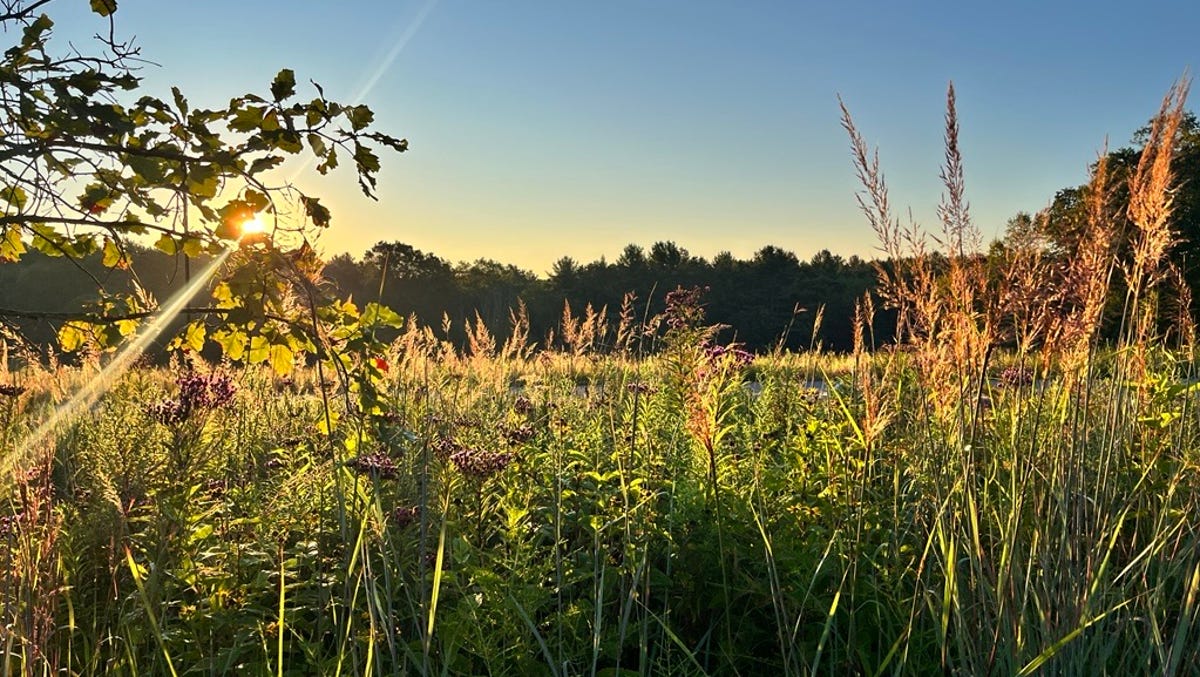From wacky weather to gardening in a smoky haze to dealing with migrating masses of our latest Biblical-grade bug invader (the spotted lanternfly), 2023 has been a roller-coaster adventure for gardeners.
But with every twist and pitfall comes the chance to learn, adjust, and maybe grow a better flower next year.
Now that the growing season has cooled to a close, let’s assess the fallout from six 2023 peculiarities.
1.) The double whammy of Dec. 23 and 24
We were sailing through a snowless and rather uneventful last December when a cold front swooped in, bringing us two inches of snow and two nights of single-digit overnight temperatures on Dec. 23 and Dec. 24.
The lows dipped to six degrees on Dec. 23 and to four degrees on Dec. 24 at the official Harrisburg International Airport weather station, but the nosedive hit zero and lower in higher and more outlying areas.
That’s dangerous ground for plants that are borderline hardy in our climate, such as the crape myrtles, nandinas, figs, camellias, osmanthus, and similar “southern” plants that central-Pennsylvania gardeners have been planting in recent years.
While that broader plant palette is a much better bet than 20 years ago, the lesson is that all it takes is a single night below a borderline hardy plant’s tolerance range for mayhem to result.
Our two single-digit December nights combined to cause more winter dieback and plant death than usual – even though the winter went on to become one of our warmest on record.
Fortunately, most of those damaged plants displayed impressive survival mojo and recovered in spring.
- Read PennLive column on 16 “southern” plants you might now be able to grow
- Read George’s post on how a very warm winter caused cold damage anyway
These magnolia flowers are turning brown from freezing temperatures overnight.George Weigel
2.) Warm-weather fakeouts
Once we got those two rogue nights out of the way, winter turned decidedly and consistently warm.
Temperatures were up to 59 degrees by Jan. 4 and 5. Every day in January went above the freezing mark. No January night was colder than 26 degrees. And January 2023 as a whole clocked in at nearly nine degrees above average.
February was nearly as balmy. Despite a few nights in the teens, February averaged 7.4 degrees warmer than usual. The high reached 69 degrees on Feb. 15 and 71 degrees a week later. No snow happened all month.
March was 1.2 degrees warmer than usual – with just a trace of snow and, like February, no snow cover.
All of that warmth sped plant development to the point where flower and leaf buds came out of dormancy sooner than they should have. Then when “normal” cold nights returned, damage happened that wouldn’t have happened if a plant were in its more protected dormant stage.
The result was brown edges around many young tree leaves, tree and shrub flowers that went brown and limp soon after opening, and in a few cases, frozen flower buds that never opened at all (yeah, you, hydrangeas).
There’s not much gardeners can do to prevent that kind of damage, other than cover plants (to the extent possible) with floating row covers or light sheets when a sudden temperature drop is forecast.
Similar trouble has been happening in the fall when lingering warmth prevents plants from gradually sliding into winter dormancy. Then when that first fall wave of really cold weather hits, plants find themselves again more prone to dieback.
Ways to mitigate that include employing those same row covers and sheets; keeping the soil damp so plants aren’t drought-stressed on top of being temperature-hijacked; maintaining a two- to three-inch layer of organic mulch (shredded hardwood, bark chips, leaves, etc.) to insulate soil, and protecting broadleaf evergreens from cold-wind injury with burlap shields.
- Read more on how to protect plants from frost and freeze damage

Gardeners found themselves watering way more than usual in May due to a record-setting dry month.George Weigel
3.) Feast-or-famine precipitation
2023′s weather also brought us curveballs with alternating spells of rain vs. no rain.
January, February, and March were all drier than usual, adding up to a deficit of more than three inches heading into the growing season.
The melting snow that used to get our roots off to a good start didn’t happen again this year. We had less than six inches of snow all winter (nearly 30 is the Harrisburg-area norm), and the vast majority of the time, there was no snow cover. (Snow is an excellent soil-insulating root-protector beyond yielding moisture.)
We caught up a bit in April with a decent five inches of rain, but just when our plants entered peak growth time, nature’s faucet shut off.
The area had less than two-tenths of an inch of rain in all of May, setting a record as our all-time driest May.
That meant a lot of uncharacteristic May hose duty for gardeners to keep those new plants alive.
Summer was more forgiving with enough rain here and there to at least keep the lawns green most of the season. But a few dry pockets in August threatened to harm young plants again before a couple of September deluges bailed us out.

Our last spring frost dates are coming earlier and our first killing frost dates of fall are happening later.George Weigel
4.) Changing frost dates
Not that long ago, Harrisburg-area gardeners could rely on the long-held rule of thumb that the last frost of spring usually happened somewhere around early May, and the first frost of fall usually happened around the third week of October.
If you go by the averages since 2000, those norms are out the window.
According to National Weather Service climate data, the average last killing-frost date in the past two decades in the Middletown/Harrisburg area is April 11, while the first killing-frost date of fall now averages Nov. 2.
This past season is a good indicator of how much our growing seasons have been expanding – up to nearly seven months now.
Last fall, we didn’t have our first killing frost until Nov. 14, 2002. Our last killing frost this spring was April 9.
Now that doesn’t mean we can all start planting tomatoes on April 10 or expect our annual flowers to keep blooming into mid-November.
Remember, averages are averages, and they don’t rule out the one-offs that can still easily derail efforts. Example 1: a sudden fall frost happened here on Oct. 9, 2001. Example 2: much of central Pennsylvania experienced a frost the day after Mother’s Day as recently as two years ago.
The takeaway for gardeners is that you’ll probably get away with earlier spring plantings and later fall growth most years. But you’ll have to decide how much risk you’re willing to take – and be ready to cover plants or accept losses in cases when you guess wrong.

Smoke from wildfires may have an impact on plant growth.Dan Gleiter
5.) The effect of wildfire smoke
The most unexpected gardening glitch of 2023 came when vast wildfires in Canada brought a substantial smoky haze – primarily in June but also spotty recurrences throughout the summer.
That was more of a problem for gardeners than plants. The smoke threatened air quality enough that it wasn’t a good idea to be out there fertilizing the veggies, doing battle against weeds, or chasing deer away from the hostas.
However, there’s some evidence that wildfire smoke and ash can harm plant growth.
One 2018 study published in “Nature Communications” claimed that ozone and aerosols – two pollutants commonly in wildfire smoke – can interfere with plant growth as far as hundreds of miles downwind.
Dr. Lew Feldman, director of the University of California Botanical Garden at Berkeley, points to research showing that even short-term exposure to smoke (as little as 20 minutes) can slow plant photosynthesis by destroying chlorophyll (the light-capturing green pigment in plants) and slowing plants’ uptake of carbon dioxide due to fine ash clogging leaf pores.
Dr. Mark Jeschke, agronomy manager for the Pioneer crop-seed company, also points to the haze itself, which can block sunlight.
“Much like a hazy cloud cover, smoke reflects a portion of incoming sunlight, reducing the amount of light available to plants,” he wrote in a paper on wildfire smoke’s potential effect on crop yield.
On the other hand, blocking some light can be a benefit on days when full sun and extreme heat might otherwise stunt growth. Coincidentally or not, our average temperatures for June (the peak of wildfire smoke) were 2 degrees cooler than normal even while the northern hemisphere as a whole recorded its warmest summer in 174 years of national record-keeping.
Another potential benefit is that fallen ash contains potassium, calcium, and magnesium that can fertilize plants once incorporated into the soil.
The bottom line is that it’s hard to determine whether the smoke this summer was a plant harmer or a wash between the pros and cons.
As Jeschke concludes: “Determining the actual impact of wildfire smoke on crop yields is extremely difficult for a number of reasons, including the multiple, competing effects involved and the difficulty in isolating the effects of smoke from other influences.”
If we get a smoky repeat in 2024, researchers recommend that concerned gardeners rinse their plant leaves to head off ash-clogged pores and to wash produce well to remove any smoke-carried residue.

Some people saw mounds of spotted lanternflies in 2023 while others were wondering where last year’s masses went.Penn State Extension
6.) Lanternflies, where are you?
One of summer’s biggest mysteries was the question, “What happened to all of the lanternflies?”
The flip side has been, “Where did all of these lanternflies come from all of a sudden?”
It turns out that spotted lanternfly populations seem to move in masses from one area to another, leading to a boom-or-bust cycle that’s been perplexing gardeners on both ends.
The good news is that even in massed populations, lanternflies are not causing serious, lasting, or widespread damage to landscape plants. They seem to be a bug that ranks higher on the people-nuisance scale than on the plant-mayhem one (with the exception of grapes).
Shannon Powers, press secretary for the state Department of Agriculture, said that researchers are finding that lanternfly populations seem to peak in the third year after they first arrive in an area. Then the population can suddenly crash as the bug moves on.
That explains why people in York, Cumberland, Perry, and counties west are reporting some of the biggest lanternfly outbreaks (it’s year three there), while folks in Dauphin County are wondering where the lanternflies went.
Lanternfly numbers similarly crashed in 2021 and 2022 in the Philadelphia area after graduating beyond three years from its first appearance.
Penn State Extension horticulture educator and spotted lanternfly researcher Brian Walsh suggests that this cycle might hinge on several factors, including lanternflies moving into untouched feeding grounds, weather vagaries, and the status of predators.
Just because a lanternfly outbreak comes and goes, though, doesn’t mean they’re gone for good.
Like Japanese beetles and many other pest bugs, populations can run in cycles ad infinitum.
- Read PennLive post on the lanternfly boom or bust








